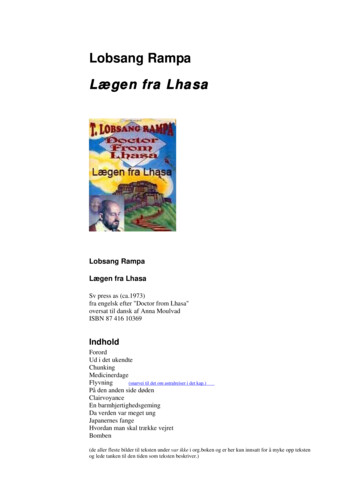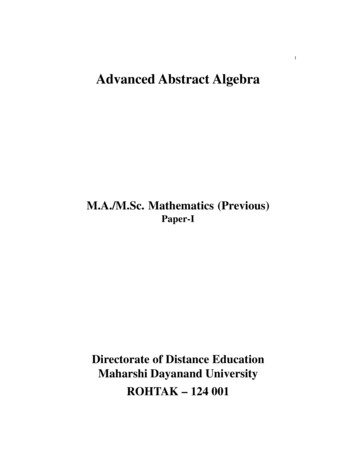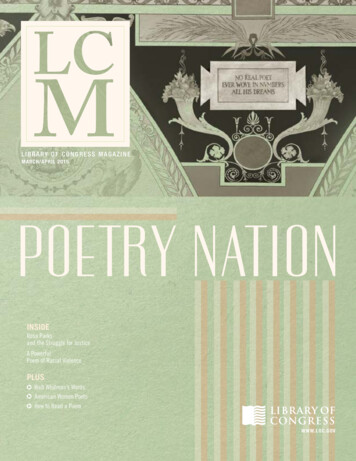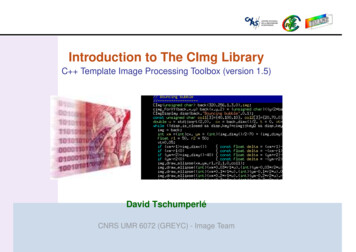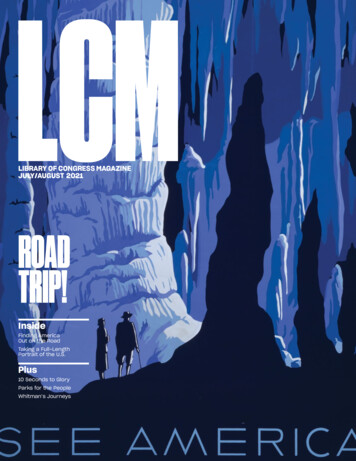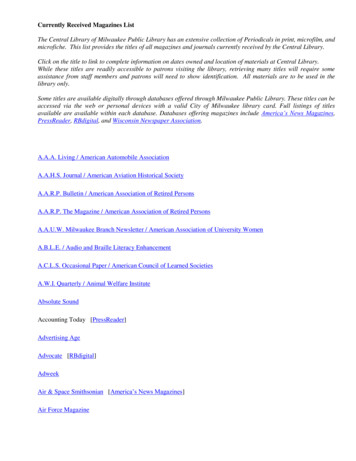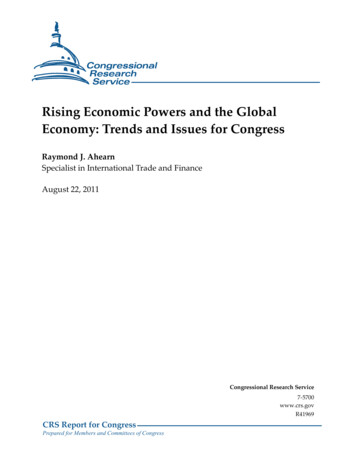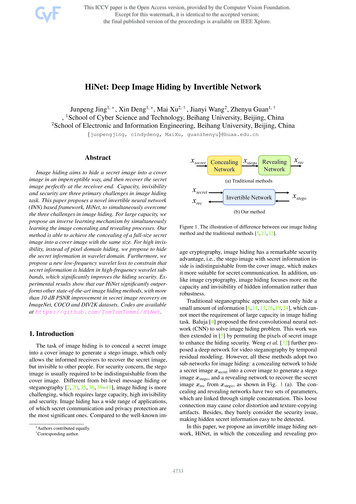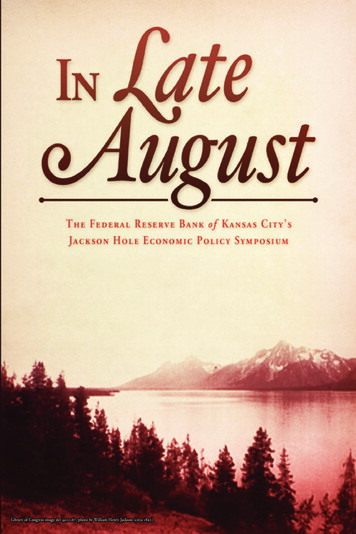
Transcription
Library of Congress image det 4a32167, photo by William Henry Jackson (circa 1892).
In ate ugustThe Federal Reserve Bank of Kansas Cit y’sJackson Hole Economic Policy Symposium
In ate ugustThe Federal Reserve Bank of Kansas City’sJackson Hole Economic Policy SymposiumPublished by the Public Affairs Department ofthe Federal Reserve Bank of Kansas City1 Memorial Drive Kansas City, MO 64198Diane M. Raley, publisherCraig S. Hakkio, content advisorKristina J. Young, associate publisherLowell C. Jones, executive editorTim Todd, co-authorBill Medley, co-authorCasey McKinley, designerCindy Edwards, archivistAll rights reserved, Copyright 2013 Federal Reserve Bank of Kansas CityNo part of this book may be reproduced, stored in a retrieval system, or transmitted inany form or by any means, electronic, mechanical, photocopying, recording or otherwise,without the prior consent of the publisher.First Edition, 2011First Edition, Second Printing 2013In Late August iii
ontentsvii Introduction1‘Monetary Policy Issues in the 1980s’August 1982 Grand Teton National Park, Wyo.9‘World Agricultural Trade: The Potential for Growth’May 1978 Kansas City, Mo.15 ‘Modeling Agriculture for Policy Analysis in the 1980s’September 1981 Vail, Colo.23 ‘Price Stability and Public Policy’August 1984 Grand Teton National Park, Wyo.29 ‘Central Banking Issues in Emerging Market-Oriented Economies’August 1990 Grand Teton National Park, Wyo.37 ‘Maintaining Financial Stability in a Global Economy’August 1997 Grand Teton National Park, Wyo.43 ‘The Greenspan Era: Lessons for the Future’August 2005 Grand Teton National Park, Wyo.51 Afterword57 Appendix60 Images from the Jackson Hole Symposium62 Jackson Hole Economic Symposium Team63 Bibliography66 Photo Credits68 IndexContents v
Ocean/CORBIS, photo by unknown photographer (1981).Each year, participants from across the globe gather in Jackson Hole,Wyo., to discuss important policy issues of mutual interest. The areais one of America’s most beautiful national parks, and is located inthe Tenth Federal Reserve District, which is served by the FederalReserve Bank of Kansas City.
IntroductionFor more than three decades, the Federal Reserve Bank of Kansas Cityhas hosted the annual Economic Policy Symposium in Jackson Hole,Wyo. It is an honor for our Reserve Bank to be involved in organizing andfacilitating a forum that brings together central bankers, private marketparticipants, academics, policymakers and others to discuss the issuesand challenges we hold in common.Removed from the day-to-day political and market pressures, this event takes placeeach year within the Kansas City Fed’s region. This site, which allows attendees to step backand challenge their assumptions, is a key component of the Symposium’s success.My predecessors, former Kansas City Fed presidents Roger Guffey and Tom Hoenig,contributed importantly to the Symposium’s reputation, yet understood, as I do, that theSymposium’s continued success is not the result of any single person or institution. We dependon a worldwide network of experts to plan each year’s event and to ensure the discussions thathappen here remain candid and relevant. The Symposium’s reputation of excellence is due tothe efforts of past participants, speakers and many others who have recognized an event likethis cannot take place without widespread collaboration and input.Each year, we publish the results of this work in the form of proceedings on our websiteat www.KansasCityFed.org. There, you can find the papers, commentaries and discussions frompast Symposiums, as well as more information about the event and its history.This short history of the Symposium, which was first published in 2011 to mark the35th symposium, details the efforts of those who have been involved in various roles, but itwould be impossible to highlight the work of everyone who has contributed in a meaningfulway. It is my hope that this volume provides a glimpse into how a diverse and dedicatedgroup of people has helped make the Symposium what it is today. We are sincerely gratefulfor their dedication, ideas and efforts through the years.In the following pages, you will find stories about these individuals and the placewhere they gather annually in late August.Esther L. George,President and CEO,Federal Reserve Bank of Kansas CityIntroduction vii
Ric Ergenbright/CORBIS, photo by Ric Ergenbright (October 10, 1985).The town square of Jackson, Wyo., is framed by one of four massive arches constructed of elk antlers.The U.S. Fish and Wildlife Service administers the National Elk Refuge nearby.
“ onetary olicy Issuesin the 1980s”August 1982 Grand Teton National Park, Wyoming“ e had a conference in late ugust,always in Jackson ake odge.”1-Roger Guffey , President, Federal Reserve Bank of Kansas City, 1976-91There’s a small but very sharp bite in the air early on many August mornings in theGrand Tetons of northwestern Wyoming.It isn’t just a hint of autumn. It is something more—a promise that winter will followsoon and that it will be tough here. Go to the town square in Jackson, Wyo., to admirethe four massive arches built from elk antlers on display and you’ll see streets lined withfour-wheel-drive vehicles, many topped with ski racks or fronted by snow blades. Here, thewinter changes how you live.Washington, D.C., in the summer is hot.It’s exactly what you’d expect for a city built along a river swamp in the south—notjust the usual summer heat, but something that engulfs you. The mercury may go higher inother parts of the United States, but few places are more uncomfortable than Washingtonin the summer when the humidity tests 90 percent and the sun beats down. And then itdoes the same thing tomorrow. And then the day after that. There is no relief in the breezehere. When the wind blows, it almost always comes hot and from the south. Here, thesummer manhandles you.In the summer of 1982, perhaps no one was battling more Washington heat thanFederal Reserve Chairman Paul Volcker. A trip to the cool air of Wyoming that August hadto offer the promise of some relief.1. Interview with author, Aug. 28, 2008.Monetary Policy Issues in the 1980s1
Bettmann/CORBIS, photo by Leighton Mark (July 17, 1985).Three years earlier, under Volcker’s leadership, the Federal Open Market Committee announced that it would no longer implement monetary policy by targeting the federal fundsrate, but would instead fight mounting inflation in the economy by concentrating on themoney supply, leaving the markets to determine interest rates. As a result, in 1981 the federalfunds rate touched a record high of 20 percent while inflation moved above 13 percent.This solution to the inflationproblem was putting the economyinto a recession, where Americansfaced not only historically high borrowing costs and rising prices, but alsodouble-digit unemployment rates. Tono surprise, this battle against inflationleft the Fed chairman fighting criticsfrom all sides, including a presidentwho had won the 1980 election in parton public dissatisfaction with how theeconomy had performed under his predecessor and a Congress that was wearyof hearing from angry constituents.But if Volcker came to Wyomingin search of respite, either through achance for a little of his beloved fly Under the leadership of then-Federal Reservefishing or to enjoy the cool morning Chairman Paul Volcker, the FOMC took toughbreeze at the Jackson Lake Lodge, he measures to successfully tame inflation.would find precious little relief at the symposium.This was not a vacation. Economists, by nature or nurture, are like living and breathing versions of the Picassopaintings that show both sides of a solitary image. So well-known is their use of the phrase“on one hand but on the other hand,” that President Harry Truman once famouslyasked for a one-armed economist to provide him with economic counsel.Put nearly 100 well-known economists in a room at a difficult and controversialperiod for the economy, make the topic “Monetary Policy Issues in the 1980s,” and theywill have much to say.2 Monetary Policy Issuesin the 1980s
“Reflecting the reward structure in academia and sincere disagreements over theconduct of monetary policy, criticisms of Fed actions are in ample supply,” Penn State2University Economics Professor Raymond E. Lombra told symposium attendees. “Moregenerally, there is little doubt that academic economists and monetary policymakers arefrequently disappointed with one another.”Lombra’s comment came after a presentation by Edward J. Kane, an economist whowas then at The Ohio State University, that included some especially strong commentsabout the Fed and, more directly, about Volcker’s leadership.“Depending on which economic indices one emphasizes and how one takes intoaccount other potentially relevant developments, the (October 1979) change in FOMCpolicy framework can be portrayed as spectacularly successful, relatively unimportant orabsolutely disastrous in its effects,” Kane said.In Kane’s view, it was the third option. The move had been a mistake.He then listed for symposium attendees the five macroeconomic developments thathad occurred since the change in Fed procedure:1. Higher interest rates and growth in substitutes for traditional forms of money;2. Generally slower growth rates in the monetary base, M1, and real GNP;3. An increase in the volatility of interest rates and in the growth rates of monetaryaggregates and GNP;4. Higher unemployment, bankruptcy and foreclosure rates; and5. A substantial reduction in the average rates of inflation.He followed the list by saying that attributing these developments to the FOMC’snew policymaking framework “is to commit the logical fallacy of post hoc, ergo properhoc. All good economists know better than to fall into this trap ”His conclusion: “ (C)hanges in FOMC procedures cannot be the ultimate cause ofanything.”The major transition that the Volcker-led FOMC had made to monetary policy wasinstead “best viewed as administrative response [sic] to changes in economic and political3pressures felt by Fed officials.”Kane’s paper, which included re2. All symposium quotes, unless attributed otherwise,prints of advertisements produced by acome from proceedings volumes published by the FederalReserve Bank of Kansas City and available online at:financial institution that were /research/escp/critical of the Fed, went on to focus onarchive.cfm.3. “Monetary Policy Issues in the 1980s: A SymposiumSponsored by the Federal Reserve Bank of Kansas City,Jackson Hole, Wyoming, Aug. 9 and 10, 1982.” FederalReserve Bank of Kansas City, 1983.Monetary Policy Issues in the 1980s3
Federal Reserve Bank of Kansas City Archives Collection (1982 Economic Symposium handout from presentation by Edward J. Kane).4the political pressuresfacing the Fed, statingthat monetary policytargeting was both apolitical and economic exercise.“Strong pledgesthat the Fed will steadfastly continue to fightinflation are receivedtoo skeptically todayto have much impacton rational expectations of inflation,”Kane said. “Rationalobservers look withvirtually X-ray visionthrough Fed promisesand react instead toA presentation by economist Edward J. Kane at the 1983 symposium potentially inflationreproduced advertisements that criticized Fed policies. ary economic andpolitical consequences that reside in the federal budget deficits projected for currentand future years. They hypothesize that the growing national debt these deficits implywill be monetized if and when elected politicians become convinced that such a coursewould prove beneficial to them.”Concern about pressure from the government to monetize the debt is, of course, oneof the key reasons why the Federal Reserve’s structure blends public and private components.Volcker, who had been enduring a very public thrashing while struggling to rebuild theFed’s credibility over the past three years, was being told by Kane that it was a losing battlefor an institution that was as political as any other part of the government.Additionally, as if Volcker or other Fed policymakers in the room had not been deepin the trenches in the battle against political and public pressure, Kane also included achart of his five developments since 1979 that showed how various entities felt about the Monetary Policy Issuesin the 1980s
4.5.6.7.The Los Angeles Times, Aug. 11, 1982.The Washington Post, Aug. 15, 1982.The Washington Post, Aug. 15, 1982.The Los Angeles Times, Aug. 11, 1982.Monetary Policy Issues in the 1980sASSOCIATED PRESS, photo by unknown photographer (1981).developments. For example, it noted that interest rate volatility was disliked by everyone fromthe Reagan administration through consumers, builders and organized labor. In addition, atthat very moment, Democrats were working on legislation that supporters hoped would forcethe Fed to abandon the track that Volcker had put policy on in 1979.Finally, and somewhat oddly, Kane’s presentation also included some allegationsrelated to inside-the-Fed politics. Specifically, he said that the budgets of the St. Louisand Minneapolis Federal Reserve Banks had been slashed by the Federal Reserve’s Boardof Governors because officers of those two regional Feds had been publicly critical ofthe FOMC.Although attendees would later note Kane’s presentation as being especially brutal andunfair towards both Volcker and the Fed, he was certainly not the only Fed critic in the room.James Tobin, a Nobel Prize-winning economist from Yale University, said during one ofthe symposium’s discussions that the Fed should have lessautonomy. Monetary policy goals, he said, should be set incoordination with the government’s fiscal policy decisions.“After all, monetary policy decisions are the most momentous economic decisions the federal government makes,”4Tobin said. “It seems anomalous to me that when the budgetis planned and eventually voted, the process is completelydetached from the gentle and amateurish surveillance theCongress exercises over monetary policy.”In case there was any question about Tobin’s views,the following Sunday, The Washington Post published alengthy article by Tobin titled “Stop Volcker from Killing5James Tobinthe Economy.”In that same edition of the paper, Fed reporter John Berry described the overall environment6of the symposium as “a series of polite, but pointed, academic exchanges.”William Eaton, a reporter from The Los Angeles Times, described it a little differently,7saying that attendees “clashed sharply” and that many attendees “attacked” the Fed.One thing was certain: If Volcker had used the trip to Wyoming in hopes of catchinga few trout, others were just as eager to make sure it was the Federal Reserve that was leftdangling from a hook in Jackson Hole.5
Bloomberg Contributor/Bloomberg via Getty Images, photo by unknownphotographer (August 27, 2010).ASSOCIATED PRESS, photo by Reed Saxon (August 22, 2009).The Federal Reserve Bank of Kansas City’s1982 economic policy symposium was the first thatwas held in the event’s now-traditional home justinside Grand Teton National Park. By any measure, it was a major turning point for a conferencethat had in previous years focused on agriculturalissues. After 1982, it would come to be known inthe decades that followed as an event that was ableto host several noteworthy milestones in centralbanking history.When eastern bloc nations turned away fromFederal Reserve Chairman Ben Bernanke, communism and toward capitalism, their centralpictured at the 2009 symposium. bankers would come to Jackson Hole to engage theWest. It would be here where Alan Greenspan would give a speech defending the Fed againstthe idea that monetary policy could be used to prick a tech stock bubble. It is where, in1999, Mark Gertler and then-Princeton professor Ben Bernanke would present a paper titled“Monetary Policy and Asset Price Volatility” that would still be referenced more than a decade later with Bernanke as Fed chairman. Perhaps to the surprise of some, the event wouldbecome a place where critics of central bank policies were able to not only voice those views,but discuss them more fully with central bankers.“The Jackson symposium has had tremendousimpact,” said Harvard University professor and President Emeritus of the National Bureau of EconomicResearch Martin Feldstein, who has been a longtimesymposium participant. “This set of meetings reallyshapes thinking about policy. Some talk about aWashington consensus; I talk sometimes about the8Jackson consensus.”The list of those who have contributed to thepolicy discussions in Jackson Hole would grow Martin Feldstein has participated inlong and include leading central bankers such as many symposiums throughout the years.Jean-Claude Trichet from the European Central Bank, those from developing and emergingnations such as Iraq, and leading academics and Nobel Prize winners.6 Monetary Policy Issuesin the 1980s8. Interview, Aug. 21, 2008.
Reflecting on the event’s history years later, Tom Davis, retired senior vice president andhead of economic research at the Federal Reserve Bank of Kansas City, said the 1982 event wasa critical springboard toward its future success.“At that time, things were pretty tough for Paul Volcker (and) he was under a lot of9criticism,” Davis said. “Ed Kane ripped into Paul—unfairly I thought—but Paul handledhimself very, very well.”Although many big events would follow, it was that presentation, Davis said, thatreally established the Federal Reserve Bank of Kansas City’s economic policy symposium.“It set up conditions of lively debate,” Davis said. “We all took note of that and tried toencourage that.”9. Author interview with Tom Davis, Oct. 17, 2008.Monetary Policy Issues in the 1980s7
Federal Reserve Bank of Kansas City Archives Collection, photo by unknown photographer (circa 1975).Roger Guffey was president of the Federal Reserve Bank of Kansas Cityfrom 1976 to 1991. A Boston Fed conference inspired Guffey to think of anevent to be hosted by the Kansas City Fed. The first symposium was held in1978 in Kansas City, Mo., and focused on the topic of agriculture.8 World Agricultural Trade:The Potential for Growth
“ orld gricultural rade: he Potential for Growth”May 1978 Kansas City, MissouriThe more than 200 attendees packed into a conference room at Kansas City’s CrownCenter turned their attention to Roger Guffey as the Federal Reserve Bank of Kansas City’spresident stepped to the podium and began remarks to open the symposium on “WorldAgricultural Trade: The Potential for Growth.”“As president of the Federal Reserve Bank of Kansas City, I have the pleasant assignmentof welcoming you to our symposium on agricultural trade,” Guffey began.He noted that he was especially pleased with the diverse backgrounds representedamong the attendees, including representatives from international trade organizations andthose from outside the United States.“(This) symposium on agricultural trade represents the first of what we hope willbecome an ongoing series of conferences on important economic issues,” Guffey said. “Aswe developed this program, our major objective was to consider an economic topic aboutwhich important public and private decisions will be made during the coming years. Wealso wanted the topic to be of significant concern not only to the Tenth Federal ReserveDistrict served by this Bank, but also by the nation as a whole. A related objective was tobring together, in a suitable setting, a group of top-level decision makers from business,government and academia who have considerable expertise in the selected topic. In doingso, the symposium would serve as a vehicle for promoting public discussion and forexchanging ideas on the issue in question.”More than 30 years later, and well after the symposium’s reputation had been established,Guffey was reminded of his prescient opening remarks from that first symposium.10“Kind of heady isn’t it?” he asked as a broad smile broke across his face. “I’m feelingpretty good.” Guffey, a child of the Great Depression who was raised on a farm about a half-hour10. Author interview with Roger Guffey, Aug. 28, 2008.World Agricultural Trade: The Potential for Growth9
Federal Reserve Bank of Kansas City Archives Collection, photo byunknown photographer (circa 1985).northeast of Kansas City, was selected as the Federal Reserve Bank of Kansas City’s seventhpresident on March 1, 1976. The following year, he was invited to attend a conferencehosted by the Federal Reserve Bank of Boston focused on “Key Issues in InternationalBanking.” The Boston Fed’s event continued a series of economic conferences that hadbegun in June 1969 under the leadership of Frank E. Morris, a former Treasury officialwho had been appointed the Boston Fed’s president in the summer of 1968.“Frank was a Ph.D. in economics, he loved the spotlight and he conducted thosesymposiums like a classroom,” Davis, the retired Kansas City Fed research director, recalled11years later. “He loved to interact with people.”And, given the territory of the Boston Federal Reserve District, and Morris’ establishedprofessional background, he could attract an impressive list of attendees, including topeconomic minds from Harvard and Yale as well as top policymakers.At that time, the Boston event was something of an anomaly.“The (regional Federal) Reserve Banks under (Federal Reserve Chairman) Arthur12Burns were not to be too visible,” Guffey said later. “Frank had kind of broken thatrestraint somewhat.”And now Guffey was considering maybe breaking it a little further. He talked aboutthe idea of a conference with Davis back in Kansas City.It was a “brief, very casual comment in which heinquired whether we should have a conference of some13type of research,” Davis said. “It was not discussed inany great length between us at that time. I said, ‘Well,it’s a possibility.’”But Davis said the more he thought about it, themore he warmed to the idea. A couple of economistsworked to further develop the idea while traveling aspart of a Kansas City Fed program known as EconomicTom Davis, research director of Forums. The series of programs, the Kansas City Fed’sthe Kansas City Fed, led efforts to longest-standing tradition, involves economists givdevelop the symposium. ing evening presentations in communities across theTenth Federal Reserve District. The morning after a presentation, the economists are back inthe car, driving for hours through the sparsely populated rural regions of the Tenth FederalReserve District to their next stop. The Tenth10 World Agricultural Trade:The Potential for Growth11. Author interview with Tom Davis, Oct. 16, 2008.12. Author interview with Roger Guffey, Aug. 28, 2008.13. Author interview with Tom Davis, Oct. 16, 2008.
District’s wide spaces left ample room for conversation.“Sheldon Stahl and myself were on an Economic Forums trip,” former Kansas City14Fed Economist Marvin Duncan recalled years later. “We had a little time thinking aboutthings and we talked a good deal about this.”Stahl soon left the Bank, and Duncan was charged with fleshing out some of theconcepts and putting together a proposal for Davis.Although Davis was fond of the Boston Fed model, he also realized that Kansas City didnot have the convenient access to the same Boston area experts or the type of connectionsMorris had used to make that event a success. Kansas City would need its own model.“In assessing our staff at that time, our strongest suit was in the regional area,” Davis15said. “We focused on regional economics. We had a financial section and we had some verygood people but our strongest suit was in the region.”And Duncan was a key part of that. Davis recalled later that he also had connections.Prior to starting on his Ph.D. at Iowa State University, Duncan had worked in the private16sector and had managed a large-scale grain and livestock operation in North Dakota.“I had a wide acquaintance within the agricultural community (so) it was not thatdifficult to bring people together, to bring the best people together to these conferences,”Duncan said.Together, Davis and Duncan worked on a topic and began the planning for the firstevent—one that would be not a “conference” but a “symposium.”17The idea of calling it a symposium “came from Marvin Duncan,” Davis said. “Hewanted it to be called a symposium. I said, ‘I don’t want it to be called a symposium,that’s reminiscent of Greek times. I don’t want a symposium.’ He said, ‘Yes, it should be(a symposium).’ So I dutifully went to the dictionary to find out what the hell‘symposium’ meant.“I wrung my hands and tried again to persuade him to change it, but he refused.”Asked about it years later, Duncan downplayed the decision to call it a symposium,saying he only made suggestions to Davis and then Davis made the decision. But thenhe quickly added that if you look the symposium definition in a dictionary “it impliesa collection of experts discussing topics and carrying on an open conversation about18those topics.”14. Author interview with Marvin Duncan, Nov. 17, 2010.15. Author interview with Tom Davis, Oct. 16, 2008.16. Author interview with Marvin Duncan, Nov. 17, 2010,and author interview with Tom Davis, Oct. 16, 2008.17. Author interview with Tom Davis, Oct. 16, 2008.18. Author interview with Marvin Duncan, Nov. 17, 2010.World Agricultural Trade: The Potential for Growth11
Davis said that he finally relented because he recognized Duncan was leading theplanning for the event, “and I didn’t want in any way to discourage his enthusiasm, soI bowed to his expertise. So that’s how it came to be called a symposium rather than aconference.” As the attendees listened, Guffey continued with his opening remarks at the 1978 event.“Agricultural trade is likely to be an important policy issue in the period ahead becausethe future prosperity of U.S. agriculture will depend largely on the maintenance andexpansion of agricultural markets,” he said. “Moreover the United States and its tradingpartners are presently engaged in multilateral trade negotiations that will determine thenew environment in which trade will occur during the next few decades.”Among the presenters at the event were former U.S. Department of Agriculture Secretary Clifford Hardin and Missouri Sen. Thomas Eagleton, then head of the agriculturesubcommittee of the Senate Appropriations Committee. But, arguably, the most intriguingspeakers were the deputy trade negotiators from the United States and Europe.In broad terms, the United States at the time favored more open trade while theEuropeans favored trade barriers to protect a shrinking farm population that they viewedmore as a social, instead of economic, concern.Herman DeLange, first secretary of the Delegation of the Commission of the EuropeanEconomic Communities (EEC), told symposium attendees that while the Europeans hadalready agreed to some concessions, they were not seeing similar moves by the United States.Meanwhile, Ambassador Alan Wolf, a member of the U.S. negotiating team, said thatthe United States had made concessions but was “disappointed at the response” and that19there could be wide implications for the future of world trade.“We are insisting that world agricultural trading be designed to encourage rather thaninhibit the development of more trade,” Wolf said. “We are insisting that this lead to arationalization of world agricultural production, utilizing the comparative advantages ofeach nation.”DeLange responded that while the EEC needed U.S. farm products, the EECalso needed to reduce its agricultural trade deficit to the Unites States, which was 4 billionin 1977.“Our consumers and farmers need you but you equally need them,” DeLangesaid. “Without their considerable and regular demand backed by hard currency, your farm12 World Agricultural Trade:The Potential for Growth19. Trade comments from coverage in The Kansas City Times,May, 19, 1978.
income would be greatly reduced.“You sell us a lot and you want to sell us more. We, on the other hand, are alarmed atthe one-sided nature of U.S. farm trade.”The debate set the course for future symposiums, where open and vigorous discussionswould be a distinguishing characteristic of the event.World Agricultural Trade: The Potential for Growth13
Scott Indermaur Photography, Scott Indermaur, (2002).In 1981, the symposium explored the topic of agriculture, which played a vital role in the Kansas City Fed’sDistrict. Following the 1981 event, the symposium would move to Jackson Hole, Wyo., and focus on globaleconomic issues.14 Modeling Agriculture forPolicy Analysis in the 1980s
“Modeling griculture forPolicy nalysis in the 1980s”There were fewer than 100 people in the room when Lawrence Klein, an economicsprofessor from Wharton, stepped to the podium in Vail, Colo., to make the first presentation of the Federal Reserve Bank of Kansas City’s 1981 policy symposium.“There is no single model of an economic system,” began the paper Klein presented.“In general, a model is a simplified approximation of reality, and there must surely bemany such approximations.”The audience was the smallest at that point in the series’ brief history. After the initialKansas City event, more than 200 came to Denver the following year for a symposiumfocused on water resources, and nearly that many were in Kansas City in 1980 to talkabout the outlook for loanable funds for agricultural banks.Barry Robinson, the Bank’s public information officer at thetime, remarked years later that the Vail event’s theme—“ModelingAgriculture for Policy Analysis in the 1980s”—was “really arcane.”20But there was a reason for it.“The genesis of the first (symposium), the second, the thirdone, all had to do with exploring a topic of interest primarilyfor the regio
29 'Central Banking Issues in Emerging Market-Oriented Economies' August 1990 Grand Teton National Park, Wyo. 37 'Maintaining Financial Stability in a Global Economy' August 1997 Grand Teton National Park, Wyo. 43 'The Greenspan Era: Lessons for the Future' August 2005 Grand Teton National Park, Wyo. 51 Afterword 57 Appendix
